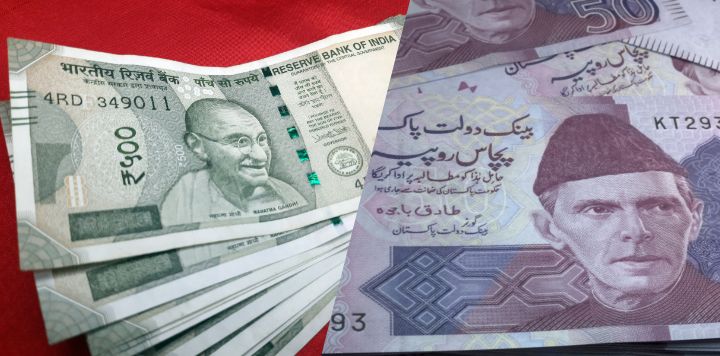The Indian Rupee (INR) and the Pakistani Rupee (PKR) share a unique history, linked not just by geographical proximity but also by a common origin. The INR is the official currency of India, while the PKR is the national currency of Pakistan. Both currencies have been subject to various political and economic factors that have affected their exchange rates over time. Continue reading to explore the exchange rate between the INR (Indian Rupee) and PKR (Pakistani Rupee), and the factors influencing their exchange rate.
What’s been the value of 1 INR to PKR since 2001 till date?
To gain a better understanding of the value of 1 INR to PKR from 2001 till date, check the table below:
| Month & Year | 1 INR to PKR |
|---|---|
| Dec 2001 | 1.23 |
| Dec 2002 | 1.21 |
| Dec 2003 | 1.27 |
| Dec 2004 | 1.36 |
| Dec 2005 | 1.32 |
| Dec 2006 | 1.38 |
| Dec 2007 | 1.55 |
| Dec 2008 | 1.62 |
| Dec 2009 | 1.81 |
| Dec 2010 | 1.93 |
| Dec 2011 | 1.72 |
| Dec 2012 | 1.78 |
| Dec 2013 | 1.72 |
| Dec 2014 | 1.61 |
| Dec 2015 | 1.58 |
| Dec 2016 | 1.56 |
| Dec 2017 | 1.66 |
| Dec 2018 | 1.99 |
| Dec 2019 | 2.17 |
| Dec 2020 | 2.19 |
| Dec 2021 | 2.36 |
| Dec 2022 | 2.74 |
| Dec 2023 | 3.36 |
| Apr’24 | 3.34 |
*Source: Trading Economics
INR to PKR Exchange Rate (2001 – 2010): The 1 INR to PKR exchange rate fluctuated significantly between 2001 and 2010. As of 2001, the value of 1 INR was equal to 1.23 PKR, however, the INR value gradually increased over the years against PKR. By 2010, the INR to PKR exchange rate reached 1.93 and the percentage rise in INR value against PKR was 56.91% over this decade.
INR to PKR Exchange Rate (2011 – 2020): In subsequent years, the INR to PKR exchange rate was comparatively less volatile. Nevertheless, there was still a steady increase from 2011 to 2020. As of 2011, the value of 1 INR was equal to 1.72 PKR, however, the INR value increased over the years against PKR. By 2020, the INR to PKR exchange rate reached 2.19 and the percentage rise in INR value against PKR was 27.33% over this decade.
INR to PKR Exchange Rate (2021 – 2024): It is pretty clear that the INR has strengthened against the PKR, despite both currencies being set at par following the partition in 1947. In the past three years, from 2021 to 2024, the value of INR has continued to rise against PKR. Gradually, the exchange rate has climbed up to 3.34 PKR per 1 INR, as of April 2024.
Factors Affecting the INR vs PKR Exchange Rate
Traditionally, economic textbooks explain exchange rates through the lens of supply and demand. In simpler terms, the value of a currency fluctuates based on how much of it is available (supply) and how much people want it (demand). While this principle is pretty accurate, however, for INR vs PKR, the relationship is far more intricate. Here are some of the key factors affecting the exchange rate:
1. Trade Flows: Trade between India and Pakistan remains relatively limited compared to their global trade volumes. However, the direction of trade plays a crucial role. Note that India typically enjoys a trade surplus with Pakistan, meaning it exports more than it imports.
2. Monetary Policies: The monetary policies of the Reserve Bank of India (RBI) and the State Bank of Pakistan (SBP) significantly influence exchange rates. Higher interest rates in India, for instance, could attract foreign investment, strengthening the INR relative to the PKR.
3. Political Tensions: Political tensions, a persistent reality between India and Pakistan, can significantly impact currency valuations. Periods of heightened tension can lead to capital flight (investors pulling out their money) from both countries, weakening their respective currencies.
4. Global Economic Factors: Other economic factors like commodity prices, inflation rates, and currency fluctuations in major economies (like the US and China) also affect the INR-PKR dynamics. For example, a surge in global oil prices could benefit Pakistan (an oil exporter) relative to India (a net importer).
Why Indian Rupee (INR) is Stronger than Pakistani Rupee (PKR)
There are several key reasons why the Indian Rupee (INR) has generally trended stronger than the Pakistani Rupee (PKR) since they started at par in 1947. Let’s delve into the factors that may have contributed to this:
1. India has a larger and more diversified economy compared to Pakistan. This translates to a stronger foundation for the INR.
2. India generally attracts more FDI compared to Pakistan. This inflow of foreign capital strengthens the INR by increasing demand for the currency.
3. India has a larger and more diverse export base compared to Pakistan. This generates a steady stream of foreign currency inflows, thus strengthening the INR.
4. India enjoys a trade surplus with Pakistan, meaning it exports more goods and services than it imports from Pakistan. This creates a higher demand for INR.
5. Political tensions between India and Pakistan may affect the PKR. Investors may perceive a higher risk associated with holding PKR during periods of heightened tension, leading to a weaker PKR.
The Future of the INR-PKR Exchange Rate
Predicting the future of the exchange rate between two currencies is a complex task. However, based on historical trends and considering current economic conditions, some potential factors that may influence the INR-PKR exchange rate going forward are as follows:
1. The relative economic growth rates of India and Pakistan will likely play a crucial role. Continued economic disparity could lead to a further strengthening of the INR. It is only if Pakistan experiences significant economic growth and development, that the gap between the two currencies could narrow.
2. Changes in the trade relationship between India and Pakistan could impact the exchange rate. Increased trade volumes, particularly if Pakistan manages to diversify its exports, could strengthen the PKR. On the other hand, any trade restrictions or political tensions could weaken the PKR further.
3. Economic factors like commodity prices, currency fluctuations in other major economies, and international trade patterns can influence both the INR and the PKR. For example, a rise in oil prices could benefit Pakistan (an oil exporter) relative to India (a net importer).
4. Political stability and improved relations between India and Pakistan could create a more favorable environment for both currencies, especially for PKR. Conversely, heightened tensions could lead to increased volatility in the exchange rate.
Conclusion:
The INR-PKR exchange rate reflects the economic realities of India and Pakistan. Though they began at par in 1947, the Indian Rupee (INR) has steadily outpaced the Pakistani currency (PKR). The continued economic disparities could definitely widen the gap in India’s favor. Nevertheless, it is evident that the history and fluctuations of the INR to PKR exchange rate are interlinked with the political and economic factors of India and Pakistan.






























Leave a Reply